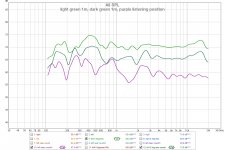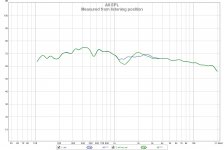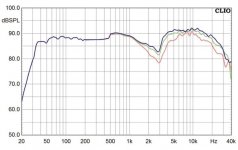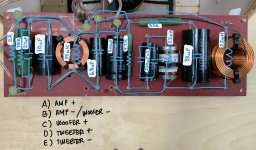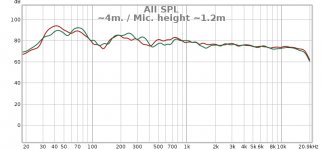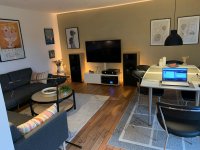A + should be visible next to one connection, as shown here in the picture:
Peerless by Tymphany DFM-2544R00-08 - 1" Compression Driver
The cable that is connected to the - of the amp must be attached to the + connection point of the tweeter.
It looks like the polarity is wrong on the measurements.
With critical music (badly produced rock like old AC / DC) this dip can even be an advantage, because it takes the sharpness out of the sound and you can hear very loudly. But it is of course a disadvantage for well-produced music.
Maybe you can change the polarity of one loudspeaker and measure again. Then you can easily compare.
Peerless by Tymphany DFM-2544R00-08 - 1" Compression Driver
The cable that is connected to the - of the amp must be attached to the + connection point of the tweeter.
It looks like the polarity is wrong on the measurements.
With critical music (badly produced rock like old AC / DC) this dip can even be an advantage, because it takes the sharpness out of the sound and you can hear very loudly. But it is of course a disadvantage for well-produced music.
Maybe you can change the polarity of one loudspeaker and measure again. Then you can easily compare.
These were quick and dirty measurements and I had some background noise to contend with. But I'm not quite sure how I'm supposed to be measuring in-room.
At 1m, tweeter level, the bump is not there. As an experiment, a draped a dish towel over the microphone mount but this resulted in a bumpier response (dark green).
Not shown are attempts with the microphone pointed up and the 90 degree calibration file but the only real difference in the calibration is lifting the response above 3-4k.
I didn't get a chance to swap because the spade connectors are different sizes and the other end of the wire is soldered. I'll need to fashion some jumpers if I want to avoid hauling the soldering station upstairs.
But the high pass crossover is correct. There is less than 1 ohm between the negative speaker terminal to positive CD terminal.
If a polarity issue, then it would be the woofer, correct?
At 1m, tweeter level, the bump is not there. As an experiment, a draped a dish towel over the microphone mount but this resulted in a bumpier response (dark green).
Not shown are attempts with the microphone pointed up and the 90 degree calibration file but the only real difference in the calibration is lifting the response above 3-4k.
I didn't get a chance to swap because the spade connectors are different sizes and the other end of the wire is soldered. I'll need to fashion some jumpers if I want to avoid hauling the soldering station upstairs.
But the high pass crossover is correct. There is less than 1 ohm between the negative speaker terminal to positive CD terminal.
If a polarity issue, then it would be the woofer, correct?
Attachments
If I understand correctly, the tweeter and woofer polarity should be in reverse:
# Amplifier + connected to woofer + terminal
# Amplifier + connected to tweeter - terminal
# Amplifier - connected to woofer - terminal
# Amplifier - connected to tweeter + terminal
This is per the crossover circuit shared in this post:
https://www.diyaudio.com/forums/multi-way/367215-asathor-jbl-4367-clone.html#post6515733
# Amplifier + connected to woofer + terminal
# Amplifier + connected to tweeter - terminal
# Amplifier - connected to woofer - terminal
# Amplifier - connected to tweeter + terminal
This is per the crossover circuit shared in this post:
https://www.diyaudio.com/forums/multi-way/367215-asathor-jbl-4367-clone.html#post6515733
Then everything should be correct.At 1m, tweeter level, the bump is not there.
It is possible that something in the room resonates at 1.5 kHz during the listening position measurement and thus causes the dip. Or you have a reflection near the microphone (table for example).
The horn bundles quite strongly vertically. If you measure significantly higher or lower than the tweeter is mounted, you also get this dip. That's why I asked about the measuring height above.
Unfortunately, such disturbances can never be completely avoided in normal living spaces. For that you would need an acoustically optimized listening room. So everything should be ok and as I said, a dip in this frequency range doesn't really matter.
Some manufacturers even build such a tuning into $ 15,000 loudspeakers:
Attachments
Looks like Wilson!
Not quite, it's a loudspeaker from a British manufacturer, which is called like Captain Nemo's submarine.
Then everything should be correct.
It is possible that something in the room resonates at 1.5 kHz during the listening position measurement and thus causes the dip. Or you have a reflection near the microphone (table for example).
Perhaps the woofer grill? I just tapped it with my finger and noticed it buzzes. I still haven't finalized its mounting.
Perhaps the woofer grill? I just tapped it with my finger and noticed it buzzes. I still haven't finalized its mounting.
Maybe, but then it should also be visible in the 1m measurement. The buzzing is of course not good either.
@Peter:
Maybe, but then it should also be visible in the 1m measurement. The buzzing is of course not good either.
It wasn't the grill. Not sure what's going on. I retried measuring and 1m again and the dip was still there. Not going to worry about it for now.
I still haven't permanently mounted the XO yet so when I get to that I'll double check what I did and perhaps remeasure the components. I recently discovered that there are two revisions of DATS v3. I have rev G but the software defaults to ref H which explains the odd measurements I got when I originally tested the components before crossover assembly.
In any case, filtering out that 40Hz spike piqued my interest in room EQ. I averaged some measurements around the seating area and had REW generate a half dozen biquad filters that plugged into the nanoDigi. The response matched the Harman room curve pretty closely so the only major filter attacked the 40Hz peak. The rest of them were much smaller corrections
Are you using Dirac? If so, how would you compare the sound before and after? I understand Dirac correction is much more than simple parametric EQ.
Lastly, I want to thank you for sharing this design and the support you've provided. It came at just the right time and I'm very pleased with result.
I have already used Dirac, but I am of the opinion that a loudspeaker should not be corrected above the Schröder frequency (in normal living rooms at around 200-300Hz), because at higher frequencies you mainly correct reflections. Our hearing can filter out these reflections well, but a measuring microphone cannot. Therefore, the results often get worse when correcting at higher frequencies.
If the bass has been corrected and everything else on the x-over fits, it should sound very good.
I am very happy if you like the result.
If the bass has been corrected and everything else on the x-over fits, it should sound very good.
I am very happy if you like the result.

Did a quick measurement. Umik mic pointing up at listening position and 90-degree calibration file used.
50dB span on y-axis is praxis...
//
That 1.5k dip bugs me slightly making me wonder if it's the room or the crossover. So I took advantage of the nice conditions and did a quick outdoor measurement.

Tweeter axis is about 3m off the ground. Mic distance was 1.3m.
I've gone over the crossover assembly and I don't see an obvious error.
Tweeter axis is about 3m off the ground. Mic distance was 1.3m.
I've gone over the crossover assembly and I don't see an obvious error.
Attachments
- Home
- Loudspeakers
- Multi-Way
- Asathor - a JBL 4367 Clone
